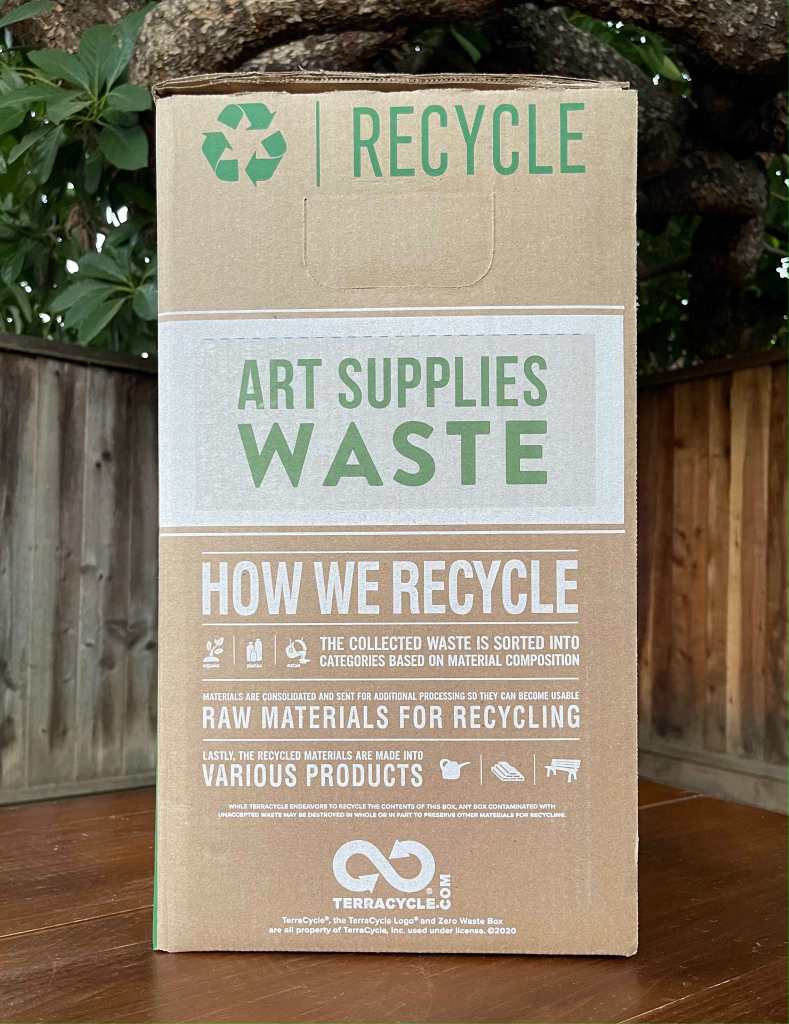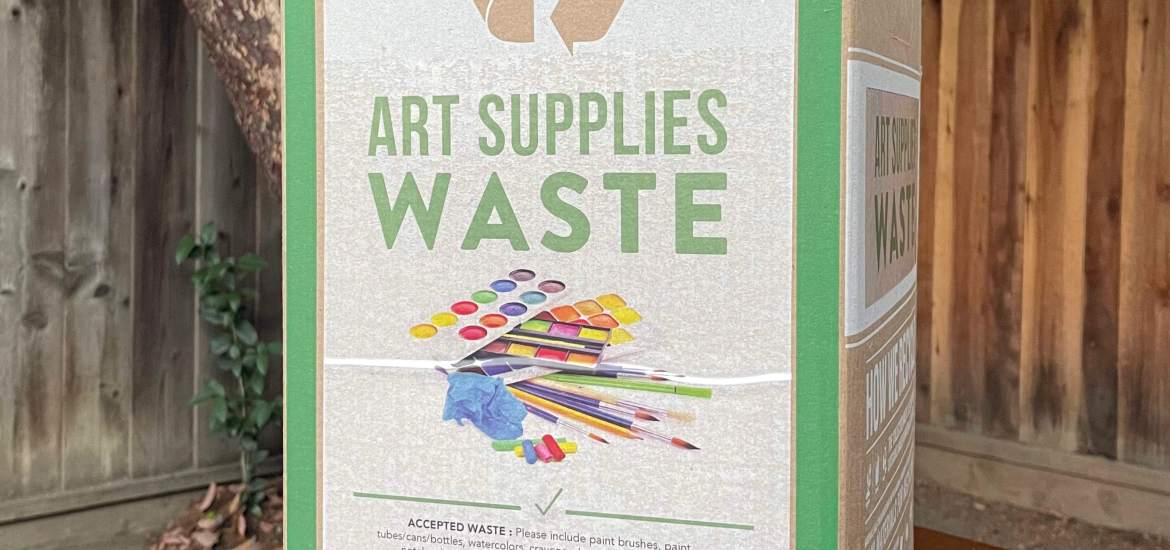I feel like I’ve bought an indulgence to reduce my time in plastic purgatory. Consider this post my 95 theses nailed to the church door.
My youngest returns to university in Canada this week and I’m still hanging onto markers that I bought for her when she teetered off to elementary school. Excessive sentimentality hasn’t transformed me into a hoarder (it does explain the dusty stack of boxes crammed with artwork though). My attempt to keep several desk drawers’ worth of plastic junk out of landfill has.
So I finally broke down a few months ago and bought a Terracycle Zero-Waste Box. Terracycle sells these sturdy cardboard boxes for various types of plastic waste that municipal recycling programs do not typically accept, such as empty toothpaste tubes, toys and sports gear, baby food pouches, baby gear and so on. You order the box, fill it up and send it back to the company to recycle, using a prepaid shipping label. And boy, did I prepay. This box cost $117. Plus tax. Some boxes cost several hundred dollars.


To be fair, Terracycle also offers many free programs. Consumers pack up plastic waste from certain brands and ship it for free to Terracycle for recycling.
Who owns the waste?
Please don’t blame municipalities for not recycling my daughter’s markers and all the other types of waste Terracycle accepts. Our waste management facilities cannot possibly handle or recycle the mountains of waste our consumer society produces. The responsibility should lie with the corporations that produce this plastic—and our governments that have not imposed laws to force companies to clean up their pollution. Don’t we teach kids right from toddlerhood to pick up after themselves? If they behaved like corporations, our homes would become dirty sock, crusty food and LEGO-filled slag heaps that we’d have to abandon every few years.
Fortunately, two states—so far—Maine and Oregon, have passed extended producer responsibility (EPR) laws that will pass the cost of recycling packaging materials where it belongs—onto the companies that produce the landfill-in-transition. Expect to see some packaging innovations soon. If my state of California already had a similar EPR law in place to address packaging, it wouldn’t help me with my current dilemma but the marker scribble would be on the wall—polluters must pay.
I can hear you saying, “But companies will just pass these costs onto the consumer.” Please keep in mind that we do pay these costs now in the form of taxes for recycling programs.
Beyond recycling
I’m not dissing Terracycle. I’m glad a company offers this option but I have a few questions:
a. How many people can actually afford this? And how many people who can afford to buy these boxes will bother when they can throw things in the trash for a fraction of the cost? Mostly the guilt-ridden will pay a premium for Terracycle to atone for their sins.
b. Does this plastic go into new products? Recycling is a market-based system. If no market exists for the raw materials that Terracycle transforms this plastic waste into, then my hoarding, packing and shipping, and Terracycle’s sorting and transforming my waste into raw materials basically does little more than ease my conscience.
c. Why must I pay for these markers twice? I paid for them when I bought them years ago, likely from Target. Now, to dispose of them responsibly, I have to pay again to keep them out of a leachate-leaking, methane-emitting landfill. Crayola should pay for this, not me. Complicit Target should also cough up some cash. (Crayola did establish a program to take back its used markers but suspended it during the pandemic.)
Will I buy another box? Maybe. I have held onto broken soccer balls, destroyed backpacks and cheap, trashed rain boots that I purchased without much thought years before I started down this low-waste path. I would love to clean out my garage.
My Reformation
I consume much less than I did back when I bought those markers. Of course, having grown children certainly helps, although once kids earn money of their own, beginning usually in their teens, controlling anything—including what comes into your home—becomes more difficult.
Today, before I buy something that could find its way into a zero-waste box, I first consider the following:
- How to dispose of the item at the end of its (usually short) life
- Whether I can find it secondhand
- The type of material it is made of
- The (usually excessive) packaging that accompanies the item
- The resources that went into its production—water, energy, labor
- The working conditions of the plant where it was made
- The country of origin and the distance to ship to me
- Whether I can find it locally from a small business
- The (usually high) cost of the item
- My willingness to pack it up and move it to a new home someday (I moved last month…)
As you can imagine, after pondering this list, I don’t buy much. The best get-out-of-plastic-hell-free card is prevention.



I have also seen some people raise questions as to how many of the items that Terracycle receives actually end up recycled. We already know that most plastics (numbers 3 and up) sell for negative per ton – meaning regular recycling facilities have to PAY someone to pick it up versus getting paid for the valuable recycling such as aluminum. And the price they pay is to incinerate or landfill the plastic instead of recycling it. Recycling these low grade plastics is much more cost intensive.
Many have pointed out that Terracycle doesn’t release any figures on the amount of product that they receive that actually gets recycled versus how much ends up in the landfill. Clearly not every piece of every single random item they receive is COMPLETELY turned into something shiny and new. So is this an expensive “feel good” trash can? I would almost bet it is. Preventing plastic in the landfill means preventing plastic being purchased in the first place.
For zero waste school supplies, look to Wisdom Supply Company! https://www.wisdomsupplyco.com/
They have Stabilo wax markers and also used to carry AusPen refillable dry erase markers made up almost completely reusable, replaceable, recycleable materials. https://www.auspen.us/collections/all
I have used Terracycle several times over several years to recycle my Tom’s Toothpaste tubes, Late July Chip bags and some other hard to recycle items. I save up the packaging, sign up, print my free postage and drop it off. So easy and these companies are a least trying to get there waste recycled! I encourage all to look at the packaging for the Terracycle logo.
I hope to see laws past as you indicate to hold these plastic polluting company accountable. Great blog, thanks!
Maybe more than 10 years ago, I signed up for Terracycle. I got a small box. I may have sent something back, I can’t recall. I do remember that I realized how futile, silly, and expensive it is. It’s one of the sneakier forms of greenwashing. Recycling and therefore Terracycle doesn’t solve any problems whatsoever. They actually create more. They create a sense of false do-gooder-ism. In the end it encourages people to continue to believe the environmental problems are solved by recycling instead of doing away with excessive plastic packaging in the first place.
In Australia, the largest office supply retailer is trialling collection of markers and pens in front of business drop off bins (in addition to batteries and small electronics), which I think is a step in the right direction towards producer responsibility. The zero waste boxes are a nice in principle, but expensive for the average person or school to fund.
I have bad news I’m afraid – and I know the people behind the lawsuit (engineers) and can vouch for their integrity
https://resource-recycling.com/plastics/2021/07/28/terracycle-and-brands-sued-over-recycling-claims/
Thank you very much for this link, Sirine!
A good post. Thank you 😊
Thank you! 🙂
You are welcome 👍🌍